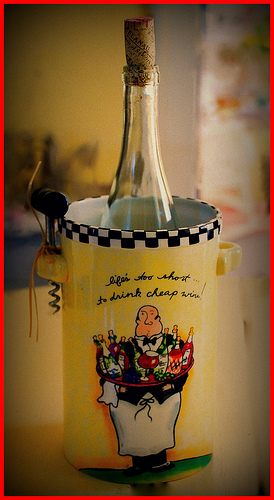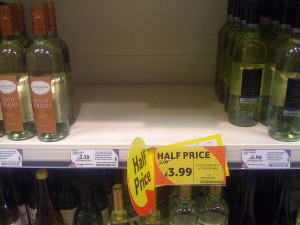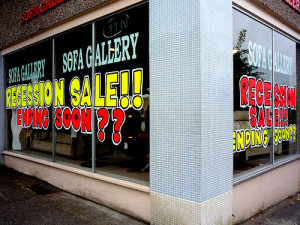Do you change your wine purchase patterns when you’re on hard financial times? Say your income drops: do you purchase the same wine but buy fewer and drink less? Do you drink the same volume of wine but purchase wines in a lower price bracket? Maybe you don’t change your wine spending habits at all, regardless of your income changes? During the recent recession in the United States between 2008 and 2012 (“The Great Recession”), income levels dropped and unemployment rose. Did this have any effect on wine purchase behavior?
Wine quality is tough to judge, particularly if you’ve never had the particular wine in question. There are a lot of different cues, known as “intrinsic” and “extrinsic”, dealing with grape variety, winemaking region reputation, growing and winemaking techniques, and so forth. Indicators such as bottle labels, wine
quality scores, or expert recommendations are also important in driving purchase decisions in wine, the individual pieces of which vary in importance depending upon a variety of demographic factors.
Some wine merchants will attach a price premium on wines from certain regions of the world, thus in a way indicating to the consumer that this is supposedly a quality wine. In terms of spending on wine, some economists say that for some consumers, the type of wine that they buy acts as a status symbol, or a symbol of wealth, therefore any change in income would not change the type of wine purchased so that the consumer is able to play the “hey, I am still wealthy” card. Studies have shown that in China, wine origin is a very important factor when determining quality, and in fact is more important than price or brand.
The recession between 2008 and 2012 not only increased unemployment and decreased income, but the use of mobile devices and using the internet for pleasure and for research purposes also increased dramatically. Studies have shown that wine is the most frequently searched for beverage online, and that social media sites have helped tremendously to increase the importance of average consumer ratings of wines and increased overall visibility by a given wine, since the internet is so magical (no wait, I mean it’s cheap and everyone and their mother uses it). So, would this increase in usage of mobile devices and social media possibly negate any negative effects caused by lower income during a recession?
A team of researchers from Seton Hall University in South Orange, New Jersey, recently explored these questions and claimed that they expected “to see a significant change in the relationship between wine price, quality, and regional reputation in the US.” The two primary hypotheses that they tested were 1) that discount rates on wine increased, in order to clear out the wine in order to make room for the next vintage, since higher priced wines may not sell as quickly during a recession; and 2) the premium on wines from particular regions decreased as a result of the recession.
Data/Methods
The data for this analysis were taken between the years 2008 and 2012, during the recession, using price and sales data from the Wine Library (one of the largest wine stores on the east coast, and has a huge online presence).
405 wines from 16 different wine regions were included in the analysis.
The data collected for each wine were: expert ratings, suggested retail price, actual retail price, discount rate, regional reputation, and the ratio of price and quality in 2008 (beginning of recession) and 2012 (end of recession).
Results
- The average discount rate at the beginning of the recession in 2008 was 22.67%.
- The average discount rate at the end of the recession in 2012 was 33.61%.
- These differences were significantly significant, meaning that the average discount rate on wines at the Wine Library was significantly greater at the end of the recession compared to the beginning.
- Average suggested retail and retail prices were lower in 2012 than they were in 2008.
- The difference between suggested retail price and actual retail price in 2008 was $1.60, while the difference in 2012 was $11.55.
- In other words, suggested retail and actual retail prices in 2008 were very similar, while in 2012, the actual retail price was significantly lower than the suggested retail price, indicating a great need to move inventory and the store’s ability to notice a decrease in purchase power by American consumers.
- In 2008 and 2012, there existed a significant regional price premium, which means that those wines from more reputable regions had higher prices than those wines from lesser known regions.
- The regional price premium, while it existed in both 2008 and 2012, was significantly higher at the beginning of the recession (2008) compared with the end (2012).
- Based on the price-quality ratios in 2008, a bottle of wine with a 90 point rating was priced at $25 if it were from Argentina, $61 if it were from Rhone, $84 if it were from Napa, or $101 if it were from Bordeaux.
- Take that same bottle of wine in 2012 (the 90 pointer), it was now priced at $23 if it were from Argentina, $43 if it were from Rhone, $55 if it were from Napa, or $63 if it were from Bordeaux.
- The regional price premium, while it existed in both 2008 and 2012, was significantly higher at the beginning of the recession (2008) compared with the end (2012).
Conclusions
The results of this study indicate that in general, decreased purchasing power as a result of decreased income during the recession in the US between 2008 and 2012 prompted retailers to significantly decrease retail prices and increase discount rates on wines. Despite the downturn in the economy, there still appeared to be a significant regional price premium for some wines, indicating that while money was tight, consumers were still willing to pay more for specific regional wines, though not quite as much as they were willing to pay in 2008.
What could have caused the decrease in regional price premiums during the recession?
The authors of this study speculated two different scenarios that may have occurred for the regional price premiums of wines to decrease between 2008 and 2012. If this decrease was actually due to the decline in income and purchasing power of Americans, then one would expect the premium to rise back up to pre-recession levels once incomes recovered. Alternatively, the authors suggested that this decrease in
regional premiums could have been due to increased information sharing online, indicating that the decrease could be permanent. In other words, regional reputation would no longer matter, as a result of a significant number of consumers talking about individual wines and spreading quality information by word of mouth. If everyone is talking about the wines online, then the quality of the wines is much less of a mystery than if you had no idea of what it tasted like before you bought it. If one reads about a wine from an unknown region that people are raving about, why spend the extra premium on a seemingly similar quality bottle of wine from a more established winemaking region?
While price premiums remaining permanently decreased due to vast information sharing online, the authors of this study speculated that this is the least likely of the two scenarios, as despite the information sharing, there may very well still be people purchasing specific wines for aesthetic purposes (i.e. maybe they want to show off their wealth and prove they have money by spending a premium for a wine from a traditionally superb winemaking region.
This study has a few limitations, indicating that the results may or may not reflect the general population as a whole. The most glaring thing for me was the fact that only one wine store was examined in this analysis. For a more accurate representation of the purchasing behavior of wine consumers during the recession, many stores from all over the United States should have been included into the analysis. Perhaps different parts of the country took more of the brunt of the recession than others? Maybe, maybe not. Perhaps these results from the Wine Library are representative of the purchase behavior of the entire US population, though there is a decent chance that it is not. Only more stores included in the analysis could answer this question, so for now, we can only guess.
What do you all think of this study? What limitations or strengths do you see in this study? What questions come to mind after reading the results of this study? Please feel free to share any questions or comments you may have regarding this study!




1 comment for “Wine Prices and Recessions: Fluidity in an Uncertain Environment”